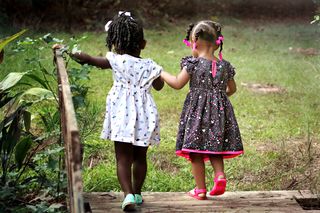Race and Ethnicity
How Do Children Acquire Prejudices?
New research examines how children acquire biases against other groups.
Posted November 1, 2019 Reviewed by Devon Frye
Most parents in the U.S. want their children to see and treat everyone equally, regardless of their race or ethnic background. They hope that if they do not point racial differences out to their children that they will not notice race, and that it will be a characteristic like hair or eye color which vary across people but bear little societal meaning. The problem is, this doesn’t really seem to work.

As a psychologist who studies how children acquire social attitudes and biases, I have heard many parents report the shame they experience when they discover that—in spite of all their careful avoidance of race—their child does notice race (and perhaps even expresses racial biases). Some parents had this realization when their child called out someone’s race in line at the grocery store (“Look, there’s a Black man!”); meanwhile, others discovered that their children seemed to show colorism (judging others based on skin tone) or were using racial stereotypes (asking whether a Black person is going to rob them).
Often, these parents are puzzled, because they have never spoken to their child about race and they wonder how such thoughts materialized. Most of these parents assume that they have to explicitly teach their children to have biases, that if they just avoid talking about race and ethnicity, their children will grow up seeing all people as equal.
The problem with this approach is that children are highly attuned to their environment—an adaptive way for them to quickly and efficiently learn how to navigate their social world. But this means that even young children notice what the people around them tend to look like, who has the most resources, and the nonverbal signals that adults demonstrate toward members of different groups. Even more importantly, children draw conclusions about the individuals and groups around them based on this information. In my research, I have looked at the role of nonverbal signals—such as facial expressions and tone of voice—in shaping children’s (and adults’) biases toward other groups.
In a recent set of studies, I decided to test whether preschool children would develop biases against a group of people based on the nonverbal signals that they saw directed toward a single member of that group. To do this, I had 4- and 5-year-old children sit down in front of a computer and watch a video recording of a social interaction between three people. One of those people was said to be from a place called “Blackpine” and another was said to be from a place called “Redvale.” In the video, the person in the center of the screen spoke to one of the other people (either the person from Redvale or the person from Blackpine) with a warm and friendly demeanor, but she spoke to the other person with a cold and contemptuous tone. We then asked children how they felt about the person from Redvale and the person from Blackpine, finding that children preferred the person who received more positive nonverbal signals.
But what we really wanted to know was whether the nonverbal signals directed toward the individuals in the video would impact children’s attitudes toward the groups—people from Blackpine and people from Redvale. When we asked children which group they liked best we saw a tendency for them to favor the group whose member received more positive nonverbal signals in the video. In fact, we saw that this bias also showed up in their behavior. Children were more likely to use the label for an unfamiliar object if it was provided by members of the group who received positive nonverbal signals. They were also more inclined to interact with members of that group, when given the choice of who they would like to do an activity with in the future.
This means that observing even just a single interaction with a member of a group could lead children to develop biases. And although my studies pitted positive nonverbal signals against negative nonverbal signals, other studies have shown that even neutral nonverbal signals can produce biases when they are contrasted with positive nonverbal signals. This implies that observing a parent or teacher seems a little less friendly toward a Black person than they usually are toward White people has the potential to produce biases among children.
The fact that children were more likely to imitate the words and actions of the nonverbally preferred group also suggests that nonverbal signals may lead children to emulate the actions and cultural practices of some groups relative to others. For example, this could lead children to devalue the music, food, or attire or a social group—merely based on the nonverbal signals that they observed directed toward a group member.
It is also important to consider the impact of children’s tendency to prefer to interact with members of the group that received more positive nonverbal signals. There is a great deal of psychological research showing support for the contact hypothesis, the notion that having close interactions with members of other groups reduces our biases against them. This phenomenon has been supported among both adults and children. But if children who observe negative nonverbal signals directed toward members of a group go on to avoid interacting with members of that group, they are missing the opportunity to reduce their biases and develop positive attitudes toward members of that group.
The evidence from all of this research points to one conclusion: Simply avoiding the topic of race with our children is not the ticket to nurturing non-biased attitudes. Our social environment provides a wealth of information about which groups are most liked, valued, and trusted in society—and often times, these messages do not align with our egalitarian ideals. In order to counteract these implicit messages that our children are exposed to, we need to start talking to our children about race and ethnicity. Stay tuned for future posts which will dig into how to approach such conversations.
References
Skinner, A. L., Olson, K. R., & Meltzoff, A. N. (2019). Acquiring group bias: Observing other people’s nonverbal signals can create social group biases. Journal of Personality and Social Psychology. Advance online publication. https://doi.org/10.1037/pspi0000218




